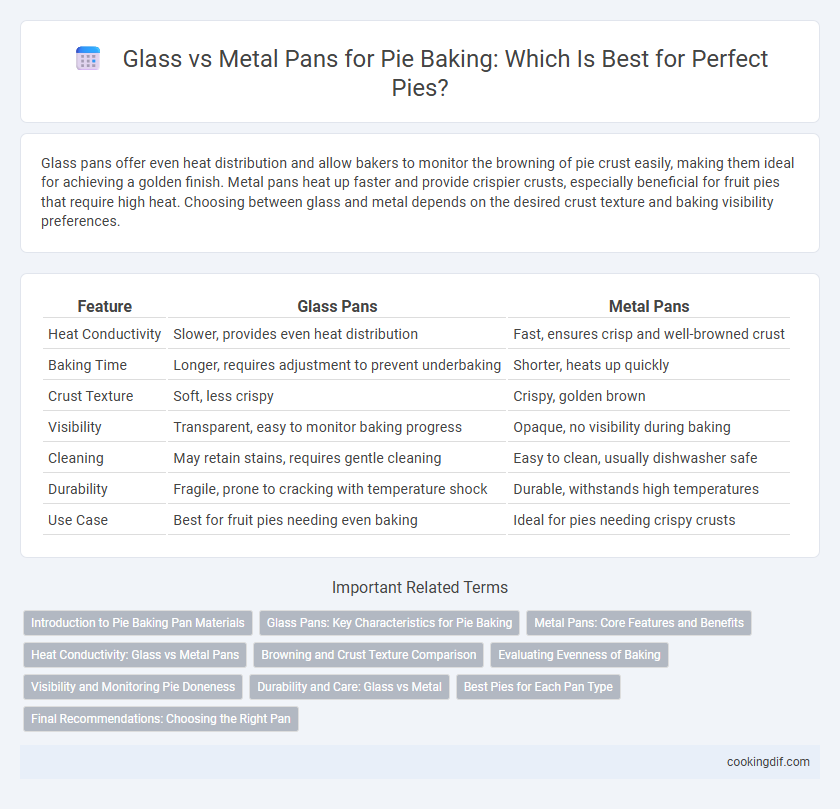Glass pans offer even heat distribution and allow bakers to monitor the browning of pie crust easily, making them ideal for achieving a golden finish. Metal pans heat up faster and provide crispier crusts, especially beneficial for fruit pies that require high heat. Choosing between glass and metal depends on the desired crust texture and baking visibility preferences.
Table of Comparison
| Feature | Glass Pans | Metal Pans |
|---|---|---|
| Heat Conductivity | Slower, provides even heat distribution | Fast, ensures crisp and well-browned crust |
| Baking Time | Longer, requires adjustment to prevent underbaking | Shorter, heats up quickly |
| Crust Texture | Soft, less crispy | Crispy, golden brown |
| Visibility | Transparent, easy to monitor baking progress | Opaque, no visibility during baking |
| Cleaning | May retain stains, requires gentle cleaning | Easy to clean, usually dishwasher safe |
| Durability | Fragile, prone to cracking with temperature shock | Durable, withstands high temperatures |
| Use Case | Best for fruit pies needing even baking | Ideal for pies needing crispy crusts |
Introduction to Pie Baking Pan Materials
Glass and metal pans are the two most common materials used for pie baking, each affecting crust texture and baking time differently. Glass pans provide even heat distribution and allow bakers to monitor the crust's color through the transparent sides, promoting a golden-brown finish. Metal pans, typically aluminum or stainless steel, heat up quickly and create a crispier crust, making them ideal for recipes requiring higher temperatures or shorter baking times.
Glass Pans: Key Characteristics for Pie Baking
Glass pans offer excellent heat retention and even baking, which helps create a perfectly browned pie crust. Their transparent nature allows for easy monitoring of the pie's bottom crust to prevent over- or under-baking. Glass pans also distribute heat slowly, making them ideal for recipes requiring gradual, consistent baking temperatures.
Metal Pans: Core Features and Benefits
Metal pans offer superior heat conduction, ensuring even baking and a perfectly crisp crust for pies. Their durability and resistance to warping make them ideal for high-temperature baking and frequent use. Lightweight and available in various sizes, metal pans provide versatility and consistent results for both amateur and professional bakers.
Heat Conductivity: Glass vs Metal Pans
Metal pans offer superior heat conductivity compared to glass, leading to faster and more even pie crust baking. Glass pans heat more slowly and retain heat longer, which can result in a slower bake and potential overcooking of the crust edges. Choosing metal pans enhances browning and crispness due to their efficient heat transfer properties.
Browning and Crust Texture Comparison
Glass pie pans offer even heat distribution, resulting in consistent browning and a crisp, well-caramelized crust. Metal pans, especially aluminum or steel, heat up faster, promoting a quicker crust formation with a flaky and tender texture. For a deeper brown and crisper edges, glass pans are preferred, while metal pans excel in creating a lighter, flakier crust ideal for delicate pies.
Evaluating Evenness of Baking
Glass pans provide consistent heat distribution during pie baking, resulting in evenly cooked crusts and fillings by retaining heat longer. Metal pans, particularly aluminum or steel, conduct heat more rapidly, promoting a crisper and more browned crust but may cause hotspots that require careful monitoring. Choosing between glass and metal pans depends on whether an evenly baked pie interior or a golden, textured crust is the desired outcome.
Visibility and Monitoring Pie Doneness
Glass pans offer superior visibility during pie baking, allowing clear monitoring of crust browning and filling bubbling without opening the oven. Metal pans conduct heat more efficiently, promoting even browning but obscure the pie's appearance, making it harder to judge doneness visually. Choosing glass enhances the ability to track pie doneness precisely, reducing the risk of overbaking or undercooking.
Durability and Care: Glass vs Metal
Metal pans offer superior durability compared to glass, resisting chipping and cracking even with frequent use or high oven temperatures. Glass pans require more careful handling due to their brittle nature, making them prone to breaking or shattering under sudden temperature changes. Cleaning metal pans is generally easier as they tolerate scrubbing and abrasive cleaners, whereas glass pans need gentler care to maintain their clarity and prevent scratches.
Best Pies for Each Pan Type
Glass pans excel at evenly distributing heat, making them ideal for fruit pies like apple or cherry, which benefit from a consistent, thorough bake and beautifully browned crusts. Metal pans, especially aluminum or steel, heat quickly and create crispier, flakier crusts, perfect for savory or custard pies such as quiche or pumpkin. The thermal conductivity of metal pans speeds up baking, while glass retains heat longer, affecting baking time and pie texture based on pan choice.
Final Recommendations: Choosing the Right Pan
Glass pans provide even heat distribution, resulting in a golden, crisp crust ideal for fruit pies, while metal pans heat up faster and are better suited for flaky, tender crusts like in savory or custard pies. For consistent browning and ease of monitoring, glass pans allow visual checking of crust color, whereas metal pans offer superior heat conductivity, yielding quicker bake times. Choose glass for precise baking and aesthetic appeal, or metal for faster cooking and a crispier crust depending on the pie type and desired texture.
Glass vs metal pans for pie baking Infographic

 cookingdif.com
cookingdif.com